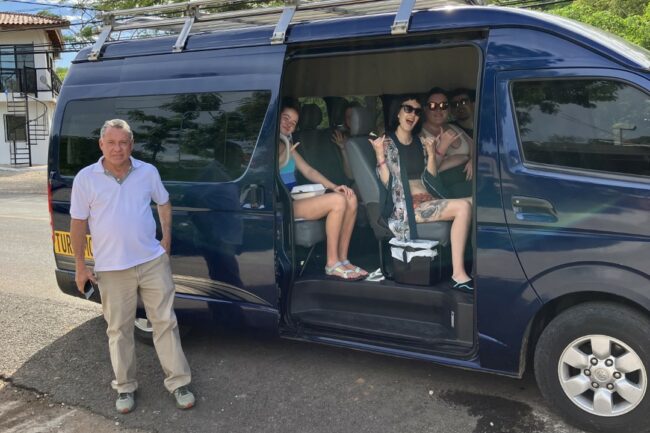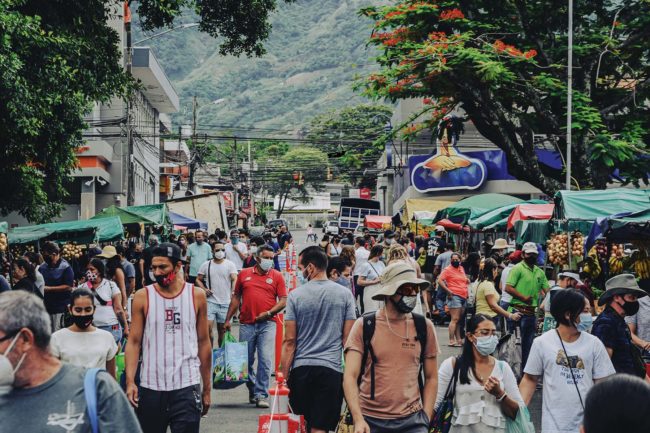Based on FAQs we get from our guests, and tips we’ve gathered from travelers in our community, we’re highlighting what we think are some of the top things to know before your visit, to help ensure a smooth, stress-free, and enjoyable trip!
- Local SIM Cards are an affordable way to ensure you have phone service throughout your trip.
Wifi is readily available at most businesses around Costa Rica (bars, restaurants, hotels, etc.), however, if you want to be able to reliably use your phone while you’re out & about, prepaid SIM cards are an easy and affordable option. You can purchase a SIM card with data plan at most grocery and convenience stores for less than $15. The main cell phone companies in CR are Kolbi, Claro, and Movistar. - Tipping is optional, but always appreciated.
Tipping at full-service restaurants in Costa Rica isn’t mandatory, because a 10% service charge is already included on most bills and is earmarked for servers. Sometimes this charge is built into the price of each menu item, or sometimes it’s added on at the end as its own line on the receipt (labeled “servicio”). Most menus will clearly indicate whether the 10% service charge and 13% VAT (value added tax) are included in the menu price or will be added in addition. With that being said, if you would like to tip extra, or tip your driver, hotel staff, or guide after receiving service, it is always very appreciated. The standard tipping amount is 10% (on top of the service charge) and you can tip in either Colones or USD. Tipping on the credit card receipt is less common here.
- USD, Colones, and Credit Cards are all widely accepted throughout the country.
United States Dollars (USD) and Costa Rican Colones (CRC) are the two currencies officially accepted in Costa Rica and can be used interchangeably. Oftentimes, if you pay for something in USD, you will receive change in Colones. The exchange rate usually hovers around approximately 650 CRC to 1 USD. Credit cards are also widely accepted throughout the country, but it’s a good idea to always keep some cash on you just in case, as smaller stores or restaurants may not accept cards. If you’re coming from the US, plan ahead by taking cash out at home, or in big cities once you arrive, as the smaller surf towns might not have ATMs very accessible to you. It’s also important to note that prices in Costa Rica are oftentimes higher than people expect, especially compared to other countries in Latin America. - Transportation to different areas of Costa Rica is generally pretty easy to find and widely available.
There are many different modes of transportation to travel around Costa Rica, the most popular being taxis and private shuttles. Taxis are reliable and easy to find in most areas, they are best for shorter distances within cities or towns and are often priced quite reasonably at approximately $1.50-$2.00 per kilometer. Uber is available in larger cities in Costa Rica, and is quite popular and generally safe. Private or shared shuttles are another great way to travel longer distances between destinations and are a very popular method of transportation throughout the country. They are also priced quite reasonably and offer higher levels of comfort for longer journeys, with air conditioning, and more legroom. Domestic flights are also available to most of the major cities throughout the country, and this can be a very time-efficient way to get from place to place, however, they are a bit more expensive.
- Renting a car is the most flexible transportation option for getting around Costa Rica, especially if you’re planning to visit multiple destinations.
Renting a car is a great option that allows for more flexibility and for you to travel at your own pace; the cost is comparable to other transportation methods, and it allows for a more relaxed trip overall. Costa Ricans drive on the right side of the road, and the age requirement for renting a car here is in the range of 21-25 years old, depending on the company you choose. It is important to drive defensively in Costa Rica, especially in the cities, as there are fewer rules of the road that are enforced, and it is not uncommon to see chickens, dogs, or cows in the streets. - Costa Rica has two international airports, LIR and SJO.
There are two international airports in Costa Rica. The bigger, more popular airport with the most flights is SJO located in the capital city of San Jose. This is oftentimes the less expensive airport to fly into and is closer to the Caribbean and southern portions of the country. The second international airport is LIR (officially Guanacaste Airport), located in Liberia, situated on the northwest side of the country in the Guanacaste province. This airport has fewer flights but is a lot more convenient to fly to if you’re heading to any west coast beach destinations such as Playa Grande, Tamarindo, Nosara, or Santa Teresa. We recommend flying into LIR when planning your visit to Playa Grande, as we are one of the closest beach towns to that airport, located just a 1.5 hour shuttle ride away. Flying into SJO is also an option, but it will require a 6+ hour shuttle/drive to arrive to Playa Grande area. - English is widely spoken throughout Costa Rica.
For the most part, it is very easy to get by as a tourist in Costa Rica without speaking Spanish, especially in the more touristy areas. English is widely spoken throughout the country, but it’s always a good idea to know a bit of the local language when you are traveling! We recommend learning a few basic words & phrases to be polite and respectful — easy ones such as Hello (Hola), Please (Por favor), Thank You (Gracias), and Yes (Sí) — or in Costa Rica, you can really say all these things with one phrase: “Pura Vida.” 🙂
- Tap water is generally safe to drink throughout Costa Rica.
Especially in busier, more touristy areas, the tap water is safe to drink in Costa Rica. Oftentimes, hotels or hostels will indicate whether or not the tap water is drinkable, but if you’re ever unsure just ask. This makes reducing single-use plastic use a lot easier, as carrying a reusable water bottle and refilling it is not only more convenient, but also cheaper too! However, in more rural areas of the country, it is best to stick to filtered water. - Depending on your plans, you’ll want to pack to prepare for all the elements — sun, rain, bugs, etc.
There are many different micro-climates throughout the country, but for the most part, it is hot and humid almost everywhere. In the mountains and in the jungle it can cool down at night, but on the coast, it is hot 24 hours a day. Some essentials to pack include, sunscreen, swimwear, sandals, bug spray, toiletries and medications, a rain jacket, a day bag, a reusable water bottle, and a small towel. Your packing list is going to vary depending on what activities you plan on doing, and what season you plan on visiting, but comfortable clothes are key, and oftentimes the lighter you pack the better. - If necessary for your next destination, Covid Tests are available at SFO and LIR airports.
As of June 2022, it is no longer mandatory to provide a negative Covid-19 test result to enter the United States. However, these regulations are still changing all the time, and vary by country, so always be sure to research your destination and double check with ample time before your scheduled travel. In Costa Rica, both international airports, SFO and LIR, provide testing on-site, and it takes less than 1 hour to receive your results. An appointment is necessary and can be booked using this link. Testing at SFO is available 24 hours a day, and at LIR it is available from 7:00 am to 4:00 pm. It is recommended that for an airport test, you book an appointment 4 hours before your flight departs, and it is $65 for an antigen test. Besides the airports, you can easily find other testing locations around CR, especially in touristy towns.
